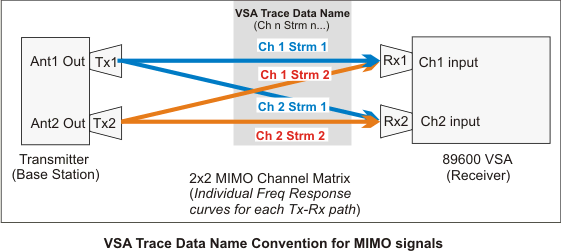Eq Impulse Response (802.11n/ac/ax/be)
is the equalizer impulse response of data stream N on measurement channel X.
Equalizer Impulse Response shows the impulse response of the equalization filter. How the is computed depends on the selection for the Equalization Training parameter. If the Equalization Training parameter is set to , the Eq Impulse is computed using only the Channel Estimation Sequence (HT high throughput-LTF Long Training field or VHT very high throughput (VHT) physical (PHY) layer protocol data unit (PPDU):A PPDU transmitted using the TXVECTOR FORMAT parameter equal to VHT.-LTF) portion of the preamble. If the parameter is set to , the is computed using both the Channel Estimation Sequence portion of the preamble and the data symbols. The latter option is typically more accurate.
The number of points in the Eq Impulse Response trace will be four times the FFT Fast Fourier Transform: A mathematical operation performed on a time-domain signal to yield the individual spectral components that constitute the signal. See Spectrum. length.
for 802.11n/ac modulation is similar to the Digital Demodulation Eq Impulse Response. The differences are:
- Digital Demodulation computes the Eq Impulse Response by comparing and data, while 802.11n/ac uses the preamble/data portion of the burst.
- Digital Demodulation typically uses a running average to average multiple scans when computing the equalizer impulse response. 802.11n/ac modulation does not average but computes a new equalizer response for each burst.
- The equalization
filter is inherent to 802.11n/ac modulation, it is not optional, cannot be enabled/disabled,
like Digital Demod.
The 802.11n/ac standard does not allow more spatial streams than channels. However, the standard does allow more channels than spatial streams, but the VSA software does not support this configuration.
Understanding the Trace Data Results
There is a Equalizer Impulse response measurement for each data stream received on a measurement channel. A one-channel, one-spatial-stream system requires only one Equalizer Impulse response measurement (Ch1 Strm1). For multiple spatial streams, there is an Equalizer Impulse response measurement for each stream received on a measurement channel.
The following graphic shows that there are four channel-stream Equalizer Impulse response measurements for a 2x2 MIMO Multiple Input, Multiple Output: A physical layer (PHY) configuration in which both transmitter and receiver use multiple antennas. (2-spatial-stream, 2-channel system): Ch1 Strm1, Ch1 Strm 2, Ch2 Strm 1, and Ch 2 Strm 2.

The number of Equalizer Impulse response measurements expand as the MIMO size, number of spatial streams and number of channel inputs increase as shown in the following table:
| Number of Channels | Eq Impulse Response Measurements | |
| 1 | Channel 1 | Stream 1 |
| 2 |
Channel 1 |
Stream 1 Stream 2 |
|
Channel 2 |
Stream 1 Stream 2 |
|
| 3 |
Channel 1 |
Stream 1 Stream 2 Stream 3 |
|
Channel 2 |
Stream 1 Stream 2 Stream 3 |
|
|
Channel 3 |
Stream 1 Stream 2 Stream 3 |
|
| ... | ||
For Nt transmit channels, the VSA supports demodulating the single stream case (Nss = 1) and the Nss = Nt stream case, even though the standard allows all variations from 1 to Nt streams.
See Also
